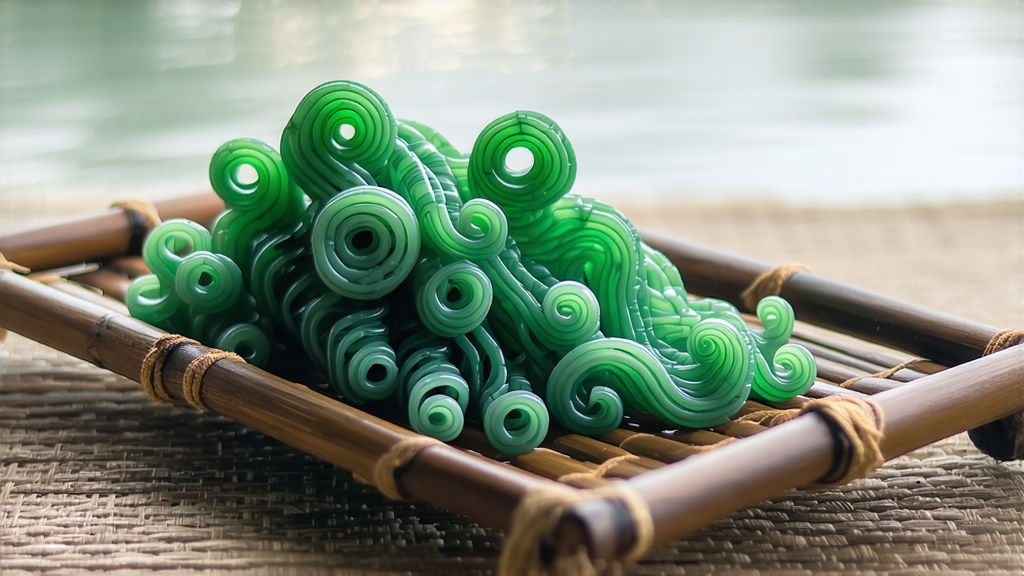
Biluochun, whose name translates literally to “Green Snail Spring,” is one of China’s ten most celebrated teas, yet it remains a quiet legend outside the circles of serious tea lovers. Produced exclusively in the mist-locked hills that rim eastern Taihu Lake in Jiangsu Province, this jade-green tea is prized for its improbably tiny spiral-shaped leaves, an intoxicating bouquet of orchid and ripe apricot, and a velvet-soft liquor that seems to distill the very breeze of early April. To understand Biluochun is to listen to a 1,200-year-old conversation between monks, emperors, tea gardeners, and the lake itself.
Historical whispers first place Biluochun in the Tang dynasty (618-907 CE), when mountain-dwelling nuns are said to have wild-foraged tender shoots, pan-fired them in woks over fruit-wood embers, and rolled the hot leaves against the inside of porcelain bowls until they curled like miniature snail shells. The tea entered written record in the Song dynasty as “Xia Sha Ren Xiang”—“Astounding Fragrance”—because courtiers swore its aroma was so penetrating that it could drift through walls. The Kangxi Emperor (r. 1661-1722) renamed it Biluochun during an inspection tour of the lake, enchanted by the leaf’s spiral form and the season of its harvest. Since then, every spring, the hills of Dongting East and West Mountains have awakened to the sound of bamboo baskets brushing against new growth, repeating a ritual unchanged at its core for more than a millennium.
Strictly speaking, only leaf plucked within a 5 km radius of Taihu’s two mountainous islands can bear the name Biluochun. Within that micro-zone, three sub-categories exist. “Original Mountain” tea comes from 200- to 300-year-old seed-grown trees rooted in weathered granite soils at 200–300 m elevation; yields are minuscule, but the cup delivers a cooling orchid note that lingers for minutes. “Traditional Garden” tea is cultivated from selected clones planted in terraced clearings first carved during the Ming dynasty; it balances intensity with accessibility and accounts for most high-grade commerce. “Lake-Edge” tea grows on lower slopes where morning mist lingers longest; its flavor is slightly softer, yet it carries a distinctive hint of water-mint picked up from the lake’s breezes. Regardless of elevation, only the topmost bud and the immediately adjacent leaf are taken, and plucking must finish before the Qingming festival in early April, when the leaf’s cell walls are still gossamer-thin and amino acids peak.
Crafting Biluochun is a race against time and oxidation. Within minutes of plucking, the fragile shoots are spread in shallow bamboo trays and left to wither for precisely 45–60 minutes, long enough for surface moisture to evaporate but short enough to preserve the bright green hue. Next comes the “kill-green” phase: leaves are hand-tossed into woks heated to 180 °C, where they are pressed, flipped, and shaken for three minutes. The goal is to rupture the cuticle just enough to release grassy volatiles while locking in the tea’s signature floral precursor compounds. Immediately afterward, while the leaf is still too hot to touch, artisans begin the spiral-rolling motion that gives Biluochun its name. Using only the heel of the palm and a silk cloth, they apply gentle pressure in concentric circles until each bud curls into a tight spring. A second, lower-temperature firing at 90 °C for twenty minutes sets the shape and reduces residual moisture to 5 percent. The entire sequence, from mountain to finished tea, rarely exceeds four hours.
Western drinkers often brew green tea with boiling water and then wonder why the liquor turns bitter. Biluochun is especially delicate; its catechin-to-amino-acid ratio is razor-thin, meaning a few degrees or seconds can swing the cup from nectar to astringent. The classical Jiangsu method calls for spring water first brought to 75 °C, then cooled for 30 seconds. A 150 ml gaiwan is warmed, 3 g of tea (roughly one heaping teaspoon) is allowed to fall gently onto the bottom, and water is poured from a height of 5 cm in a slow clockwise motion. The first infusion lasts 45 seconds; subsequent infusions add 10 seconds each. The reward is a pale champagne-gold liquor that smells unmistakably of fresh lychee and freesia. On the palate, one first notices a cooling, almost mint